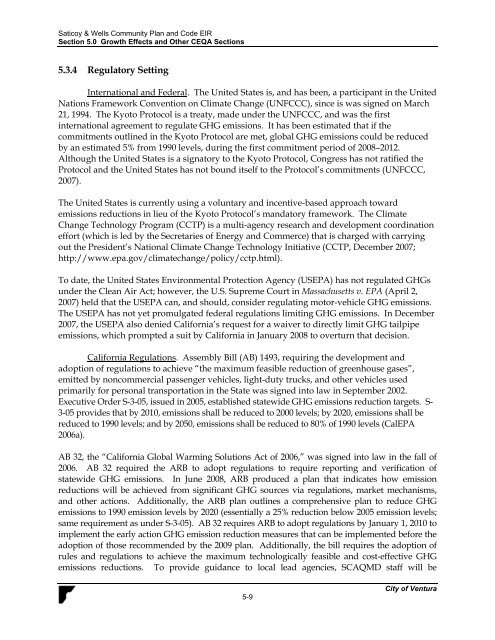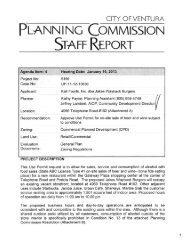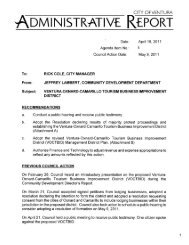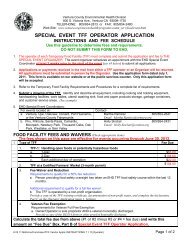Saticoy & Wells Community Plan & Development ... - City Of Ventura
Saticoy & Wells Community Plan & Development ... - City Of Ventura
Saticoy & Wells Community Plan & Development ... - City Of Ventura
You also want an ePaper? Increase the reach of your titles
YUMPU automatically turns print PDFs into web optimized ePapers that Google loves.
<strong>Saticoy</strong> & <strong>Wells</strong> <strong>Community</strong> <strong>Plan</strong> and Code EIRSection 5.0 Growth Effects and Other CEQA Sections5.3.4 Regulatory SettingInternational and Federal. The United States is, and has been, a participant in the UnitedNations Framework Convention on Climate Change (UNFCCC), since is was signed on March21, 1994. The Kyoto Protocol is a treaty, made under the UNFCCC, and was the firstinternational agreement to regulate GHG emissions. It has been estimated that if thecommitments outlined in the Kyoto Protocol are met, global GHG emissions could be reducedby an estimated 5% from 1990 levels, during the first commitment period of 2008–2012.Although the United States is a signatory to the Kyoto Protocol, Congress has not ratified theProtocol and the United States has not bound itself to the Protocol’s commitments (UNFCCC,2007).The United States is currently using a voluntary and incentive-based approach towardemissions reductions in lieu of the Kyoto Protocol’s mandatory framework. The ClimateChange Technology Program (CCTP) is a multi-agency research and development coordinationeffort (which is led by the Secretaries of Energy and Commerce) that is charged with carryingout the President’s National Climate Change Technology Initiative (CCTP, December 2007;http://www.epa.gov/climatechange/policy/cctp.html).To date, the United States Environmental Protection Agency (USEPA) has not regulated GHGsunder the Clean Air Act; however, the U.S. Supreme Court in Massachusetts v. EPA (April 2,2007) held that the USEPA can, and should, consider regulating motor-vehicle GHG emissions.The USEPA has not yet promulgated federal regulations limiting GHG emissions. In December2007, the USEPA also denied California’s request for a waiver to directly limit GHG tailpipeemissions, which prompted a suit by California in January 2008 to overturn that decision.California Regulations. Assembly Bill (AB) 1493, requiring the development andadoption of regulations to achieve “the maximum feasible reduction of greenhouse gases”,emitted by noncommercial passenger vehicles, light-duty trucks, and other vehicles usedprimarily for personal transportation in the State was signed into law in September 2002.Executive Order S-3-05, issued in 2005, established statewide GHG emissions reduction targets. S-3-05 provides that by 2010, emissions shall be reduced to 2000 levels; by 2020, emissions shall bereduced to 1990 levels; and by 2050, emissions shall be reduced to 80% of 1990 levels (CalEPA2006a).AB 32, the “California Global Warming Solutions Act of 2006,” was signed into law in the fall of2006. AB 32 required the ARB to adopt regulations to require reporting and verification ofstatewide GHG emissions. In June 2008, ARB produced a plan that indicates how emissionreductions will be achieved from significant GHG sources via regulations, market mechanisms,and other actions. Additionally, the ARB plan outlines a comprehensive plan to reduce GHGemissions to 1990 emission levels by 2020 (essentially a 25% reduction below 2005 emission levels;same requirement as under S-3-05). AB 32 requires ARB to adopt regulations by January 1, 2010 toimplement the early action GHG emission reduction measures that can be implemented before theadoption of those recommended by the 2009 plan. Additionally, the bill requires the adoption ofrules and regulations to achieve the maximum technologically feasible and cost-effective GHGemissions reductions. To provide guidance to local lead agencies, SCAQMD staff will be5-9<strong>City</strong> of <strong>Ventura</strong>
















